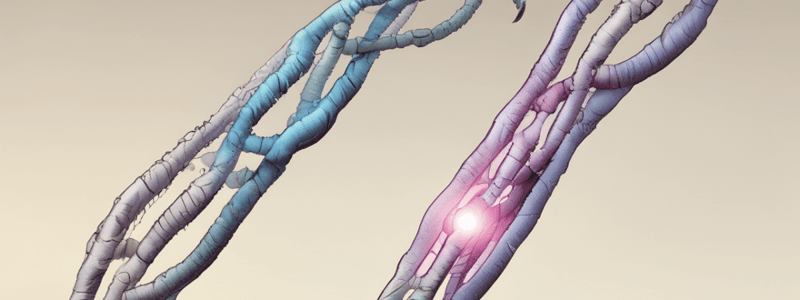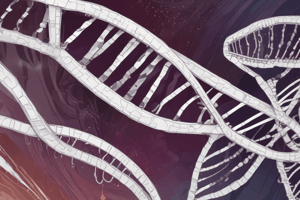Podcast
Questions and Answers
What year was the human chromosome number established as 46?
What year was the human chromosome number established as 46?
- 1959
- 1956 (correct)
- 1960
- 1923
Which technique requires cell culture to collect metaphase cells for analysis?
Which technique requires cell culture to collect metaphase cells for analysis?
- QF-PCR
- Array CGH
- MLPA
- G-banding (correct)
Which of the following is NOT a type of chromosome abnormality?
Which of the following is NOT a type of chromosome abnormality?
- Chromosome rearrangements
- Whole chromosome aneuploidy
- Gene mutation (correct)
- Copy number imbalance
What condition is associated with chromosome breakage syndromes?
What condition is associated with chromosome breakage syndromes?
Which of the following describes an outcome of whole chromosome aneuploidy?
Which of the following describes an outcome of whole chromosome aneuploidy?
Which genetic testing technique utilizes DNA instead of cultured cells?
Which genetic testing technique utilizes DNA instead of cultured cells?
Mosaicism can arise in an initially normal conceptus. What is an example of its numerical configuration?
Mosaicism can arise in an initially normal conceptus. What is an example of its numerical configuration?
What was established in 1959 regarding chromosomal abnormalities?
What was established in 1959 regarding chromosomal abnormalities?
What is the typical resolution power of G-banded chromosome analysis?
What is the typical resolution power of G-banded chromosome analysis?
Which of the following best describes the role of whole chromosome paints in FISH?
Which of the following best describes the role of whole chromosome paints in FISH?
Which application of QF-PCR is focused on during prenatal cytogenetics?
Which application of QF-PCR is focused on during prenatal cytogenetics?
What does a normal copy number indicate in chromosomal analysis?
What does a normal copy number indicate in chromosomal analysis?
Which condition is commonly associated with segmental copy number imbalances detected by FISH?
Which condition is commonly associated with segmental copy number imbalances detected by FISH?
What is the purpose of a control probe locus in FISH analysis?
What is the purpose of a control probe locus in FISH analysis?
What is the prevalence of Robertsonian translocations?
What is the prevalence of Robertsonian translocations?
Which type of translocation is known to involve segments of any non-homologous chromosomes?
Which type of translocation is known to involve segments of any non-homologous chromosomes?
Which reproductive risks are associated with balanced carriers of Robertsonian translocations?
Which reproductive risks are associated with balanced carriers of Robertsonian translocations?
In which type of chromosome inversion does the centromere lie within the inverted segment?
In which type of chromosome inversion does the centromere lie within the inverted segment?
What is a common phenotype outcome for somatic mosaicism?
What is a common phenotype outcome for somatic mosaicism?
Which statement describes adjacent segregation in the context of translocations?
Which statement describes adjacent segregation in the context of translocations?
What type of chromosomal anomaly might occur following trisomy rescue?
What type of chromosomal anomaly might occur following trisomy rescue?
What is the most common reciprocal translocation that occurs in families?
What is the most common reciprocal translocation that occurs in families?
What is the primary mechanism that leads to microdeletion syndromes?
What is the primary mechanism that leads to microdeletion syndromes?
Which microdeletion syndrome is associated with deletion on chromosome 22?
Which microdeletion syndrome is associated with deletion on chromosome 22?
In array CGH, what does a red spot indicate in relation to DNA material?
In array CGH, what does a red spot indicate in relation to DNA material?
What type of genetic variations can array CGH detect?
What type of genetic variations can array CGH detect?
What does the presence of 'low copy repeats' facilitate in the context of chromosomal imbalances?
What does the presence of 'low copy repeats' facilitate in the context of chromosomal imbalances?
What kind of imbalance is associated with genes of unknown function according to research studies?
What kind of imbalance is associated with genes of unknown function according to research studies?
What is the typical size range of submicroscopic chromosomal deletions associated with microdeletion syndromes?
What is the typical size range of submicroscopic chromosomal deletions associated with microdeletion syndromes?
Which syndrome involves a deletion on chromosome 4?
Which syndrome involves a deletion on chromosome 4?
Flashcards are hidden until you start studying
Study Notes
Milestones in Genetics
- 1842: First observation of chromosomes in plant cells.
- 1850/1860: Mendelian inheritance principles established.
- 1880-1900: Chromosomes confirmed as vectors of heredity.
- 1923: Human chromosome number determined to be 48.
- 1953: Discovery of DNA structure by Watson, Crick, and Franklin.
- 1956: Tjio and Levan reported 46 chromosomes in humans.
- Aneuploidy refers to an incorrect number of chromosomes.
Milestones in Medical Genetics
- 1959: Chromosomal basis for Down, Turner, and Klinefelter syndromes identified.
- 1960: Establishment of chromosomal basis for Patau and Edwards syndromes.
- 1962: Development of Guthrie test for genetic screening.
- 1969: Introduction of chromosome banding techniques.
- 1977: Sanger sequencing established for DNA analysis.
- 1983: Polymerase Chain Reaction (PCR) technique invented for DNA amplification.
Cytogenetics
- Focus areas include number, structure, deletions, duplications, and chromosomal instability.
Types of Chromosome Abnormalities
- Chromosome rearrangements.
- Whole chromosome aneuploidy.
- Copy number imbalance.
Techniques for Chromosome Investigation
- Traditional Cytogenetics: G-banding, Fluorescence in situ Hybridization (FISH), breakage analysis.
- Molecular Cytogenetics: QF-PCR, MLPA, Array CGH for DNA analysis.
Chromosomal Abnormalities
- Chromosome Rearrangements: Linked to recurrent miscarriages and infertility.
- Copy Number Imbalance: Causes dysmorphism, developmental delays, learning difficulties, and specific phenotypes (e.g., epilepsy).
- Chromosome Breakage Syndromes: Includes Fanconi anemia and ataxia telangiectasia.
Whole Chromosome Aneuploidy
- Caused by non-disjunction in mitosis or meiosis.
- Large genomic imbalances typically result in loss of conceptions, except in cases of gene-poor chromosomes.
- Trisomy 13, 18, and 21 are the only viable autosomal trisomies at live birth.
Mosaicism
- Can originate from non-disjunction or anaphase lag in a normal conceptus, leading to abnormal phenotypes.
- Somatic Mosaicism: May result in observable phenotypes.
- Gonadal Mosaicism: Occurs during germ cell formation, often revealed through pregnancies with de novo abnormalities.
Chromosome Rearrangements
- Robertsonian Translocations: Fusion of two acrocentric chromosomes (e.g., 13, 14, 15, 21, 22).
- Prevalence of 1 in 1000.
- Most common translocations: der(13;14) and der(14;21).
- Reciprocal Translocations: Can occur between non-homologous chromosomes, with a prevalence of 1 in 500.
- Usually unique to families except for one recurrent variant: 46,XX,t(11;22)(q23.3;q11.2).
- Inversions: Includes pericentric (involving the centromere) and paracentric (not involving the centromere) inversions.
Investigation Techniques
- G-Banding: Provides a resolution of ~5-10Mb.
- Fluorescence In Situ Hybridization (FISH): Uses fluorescent markers to detect specific DNA sequences; critical for structural chromosome analysis.
Prenatal Cytogenetics
- Traditional methods (G-banding) require ~2 weeks for results; FISH and QF-PCR provide faster results for pregnancy management.
Segmental Copy Number Imbalance
- Normal copy number for most chromosomes is 2, except for sex chromosomes.
- Deletions and duplications can manifest as microdeletion syndromes, which recur due to genomic predispositions.
Microdeletion Syndromes
- Recognizable syndromes include DiGeorge (del(22q)), Prader-Willi (del(15q)), Williams (del(7q)), and Angelman (del(15q)).
- Caused by submicroscopic chromosomal deletions due to unequal recombination.
Array Comparative Genomic Hybridization (Array CGH)
- Detects whole chromosome aneuploidy, microdeletions/duplications, subtelomere imbalances, and copy number variants.
- Studies show that normal individuals may carry multiple small copy number variations (CNVs), contributing to phenotypic variations.
Clinical Implications
- Identifying unreported imbalances can be complex, as genes involved may not correlate directly with the presenting clinical features or indications for referral.
Studying That Suits You
Use AI to generate personalized quizzes and flashcards to suit your learning preferences.



